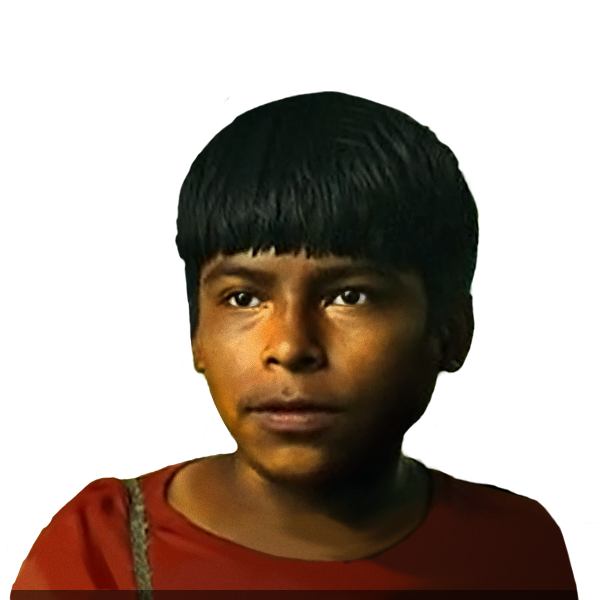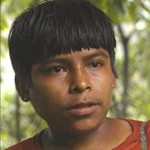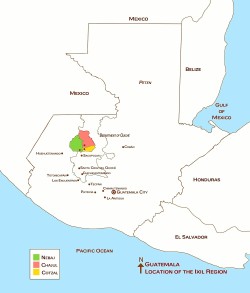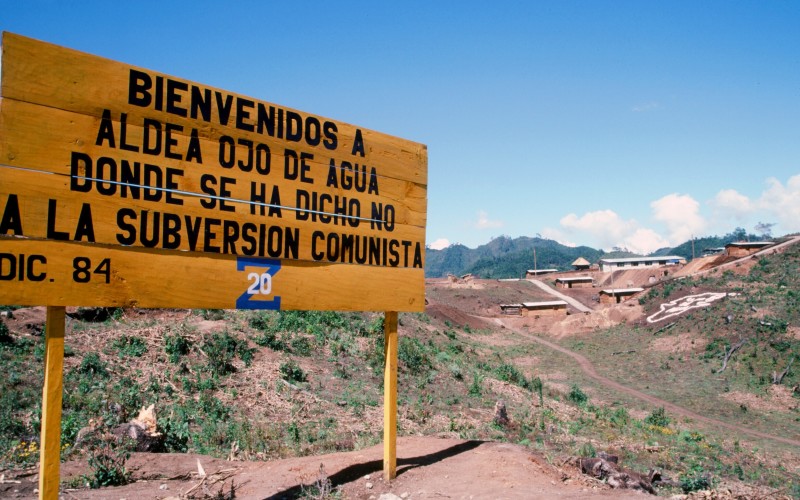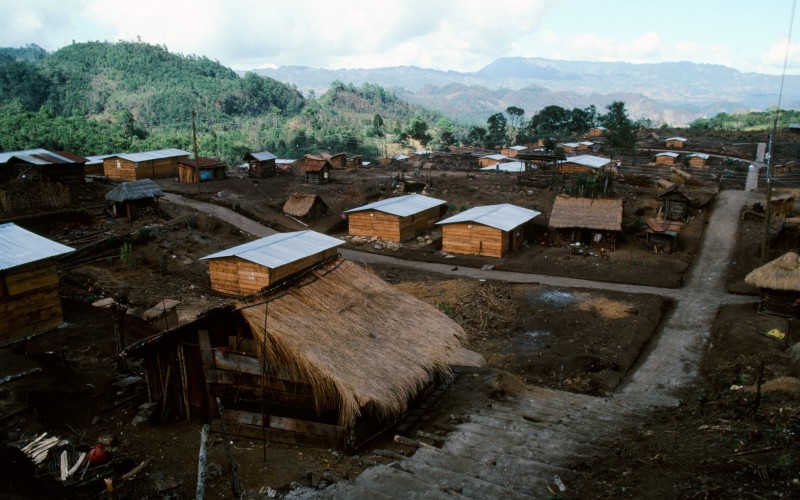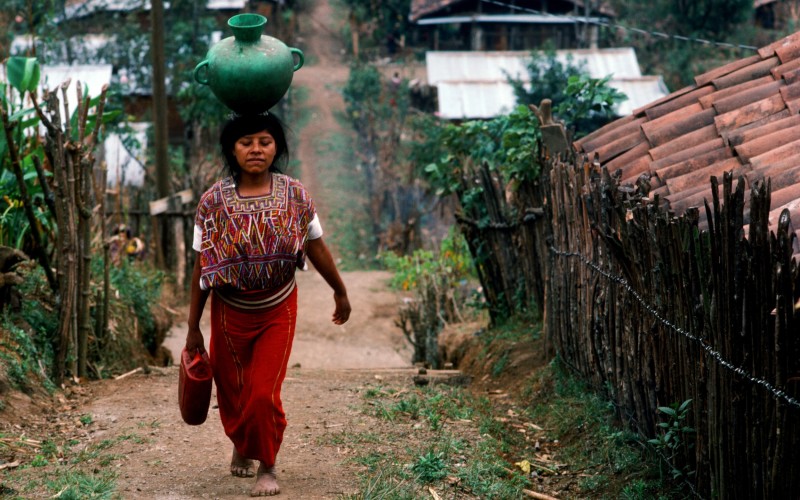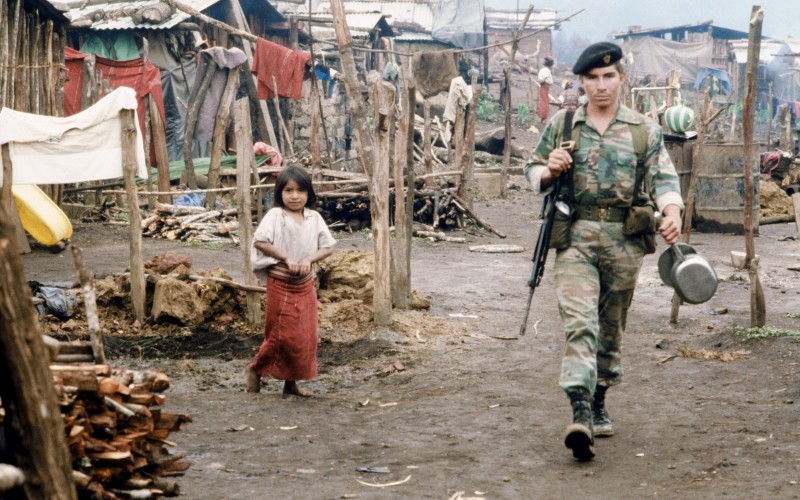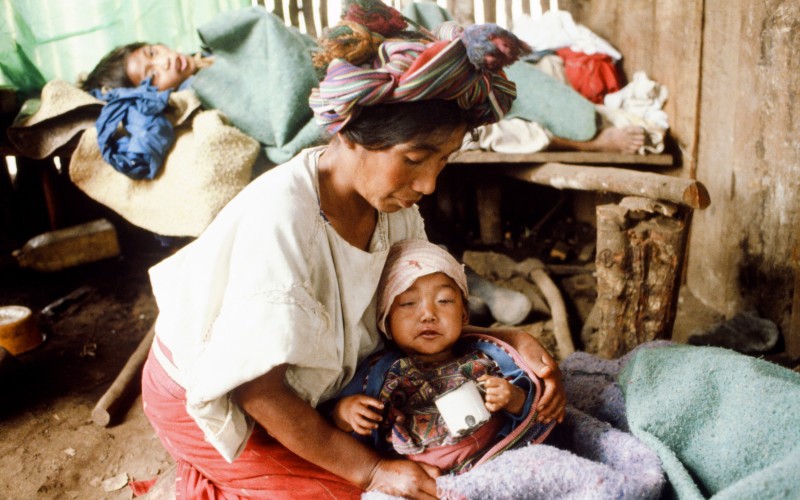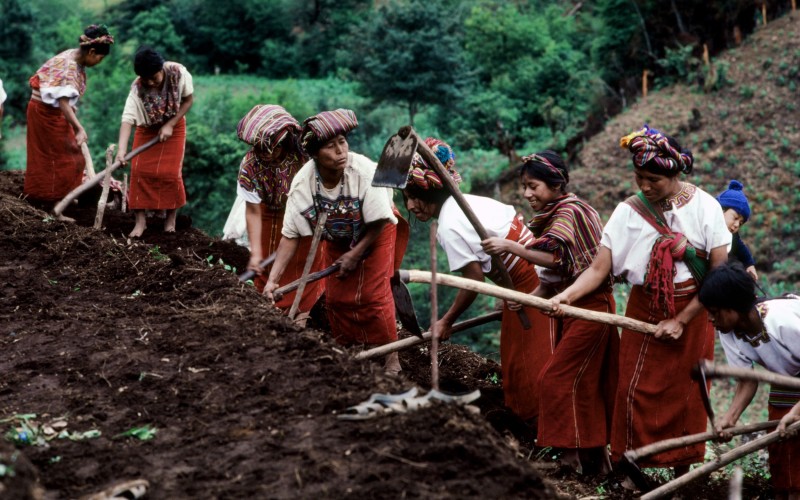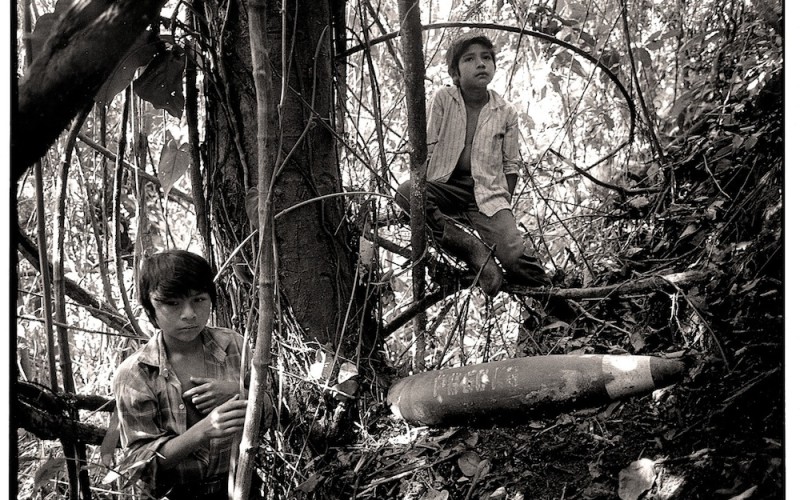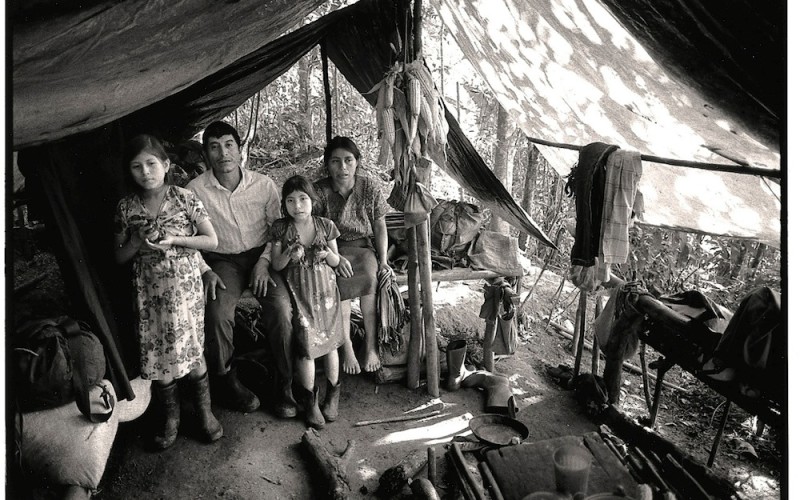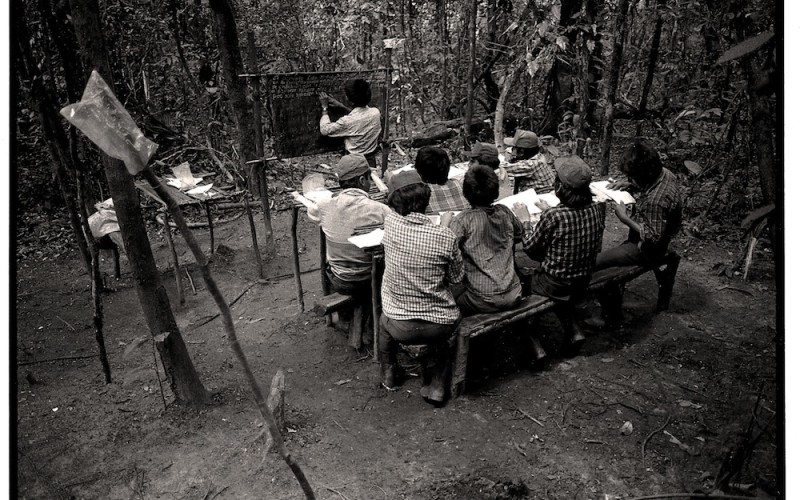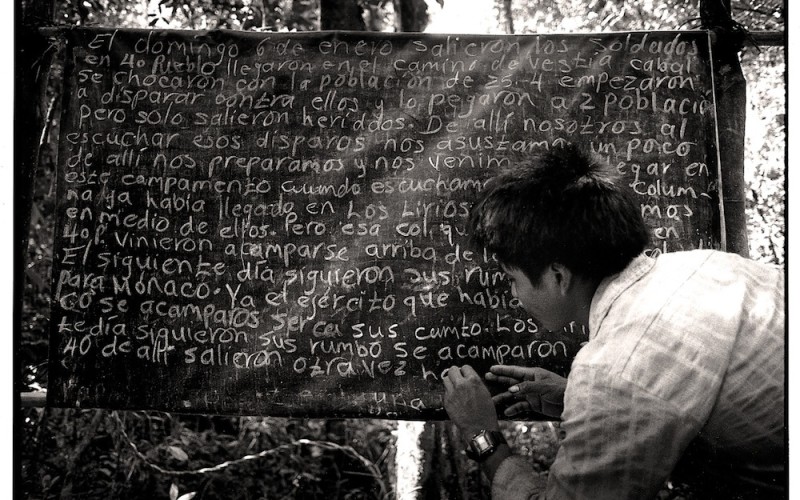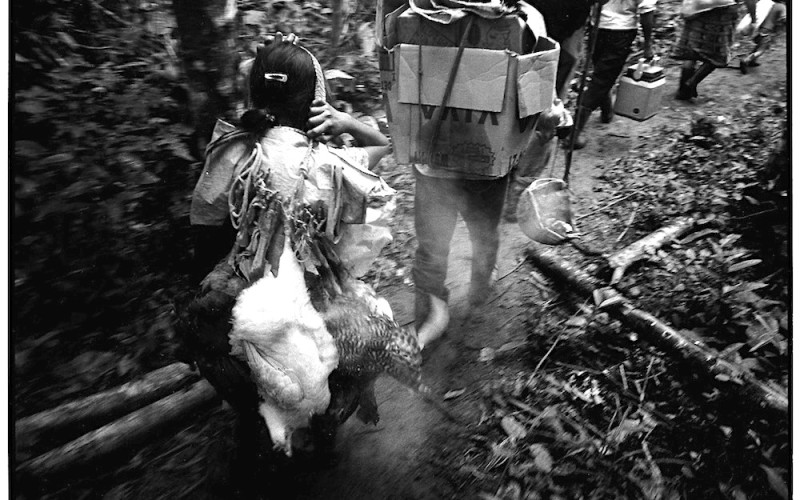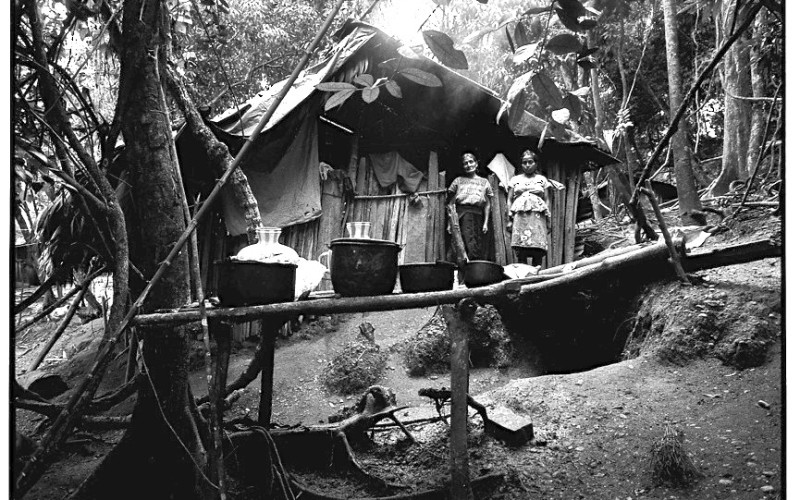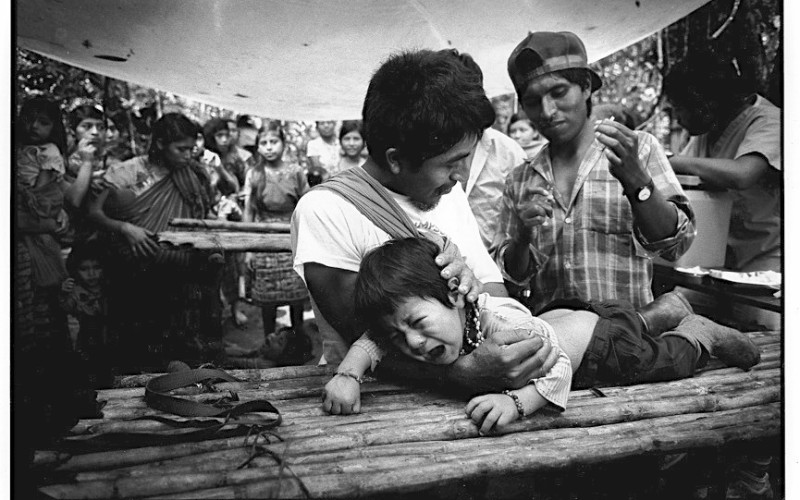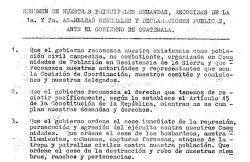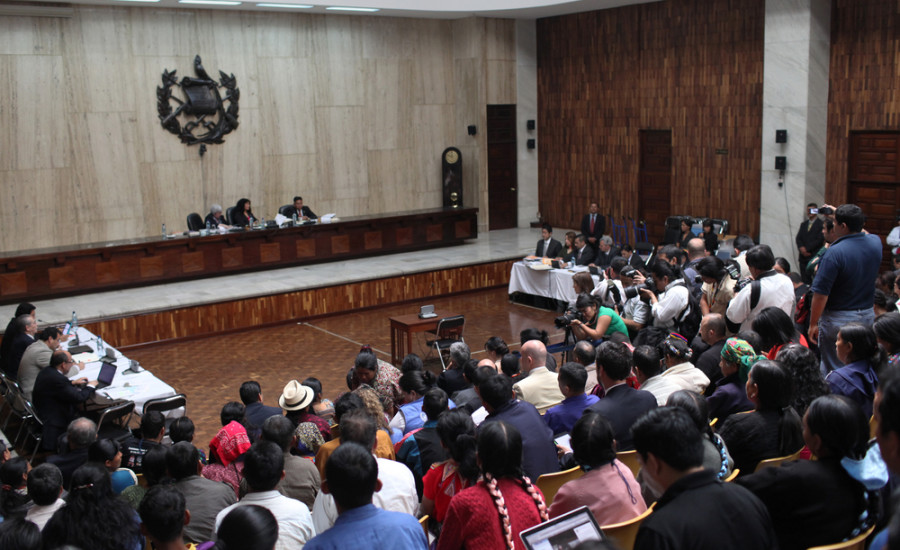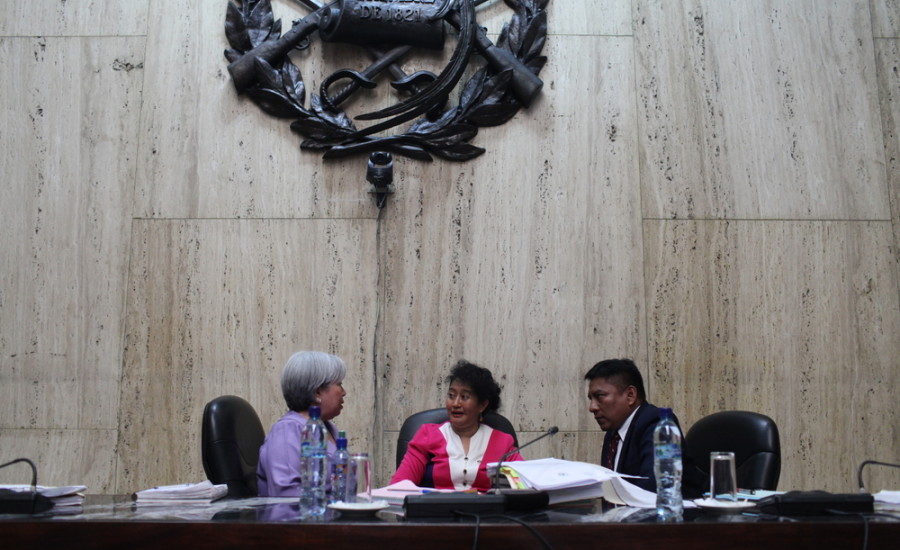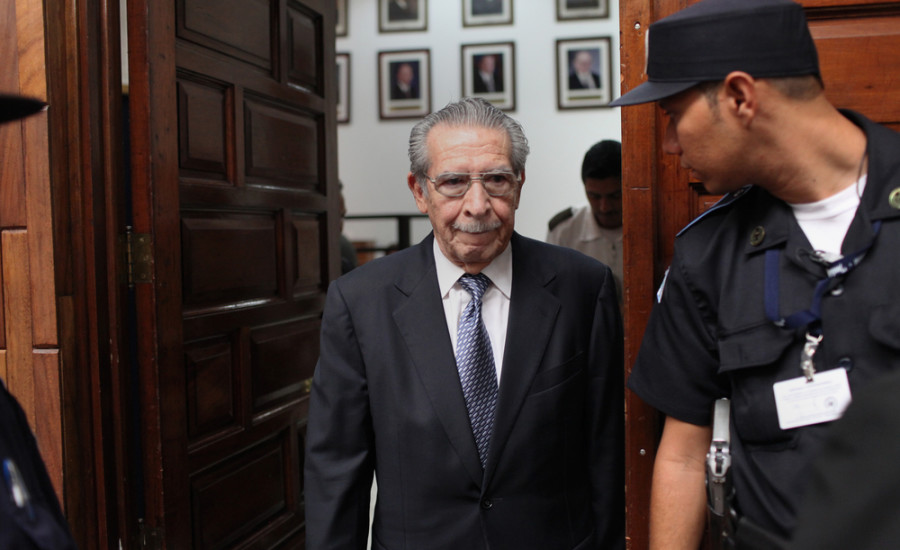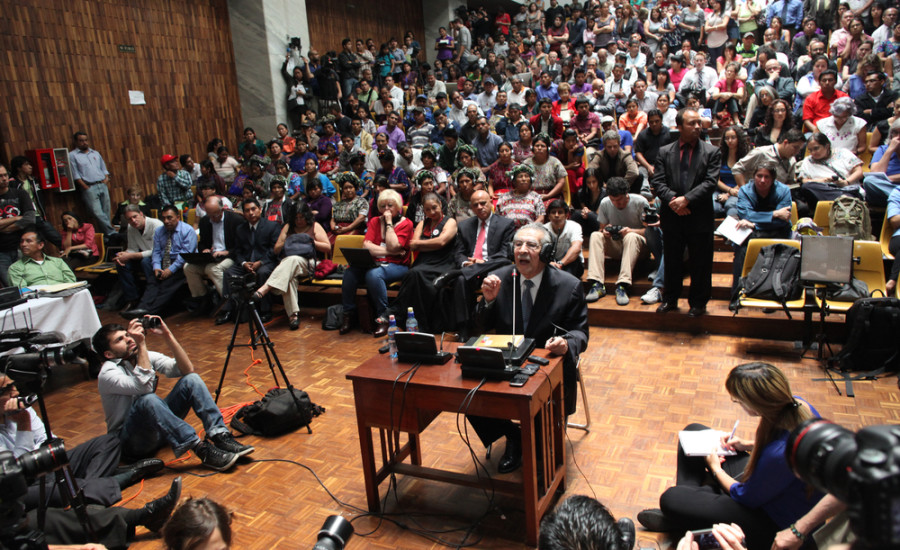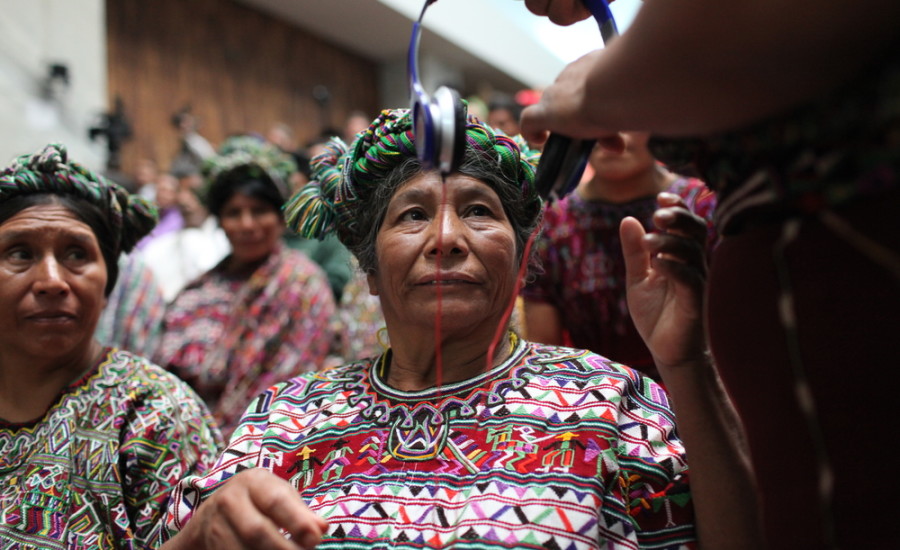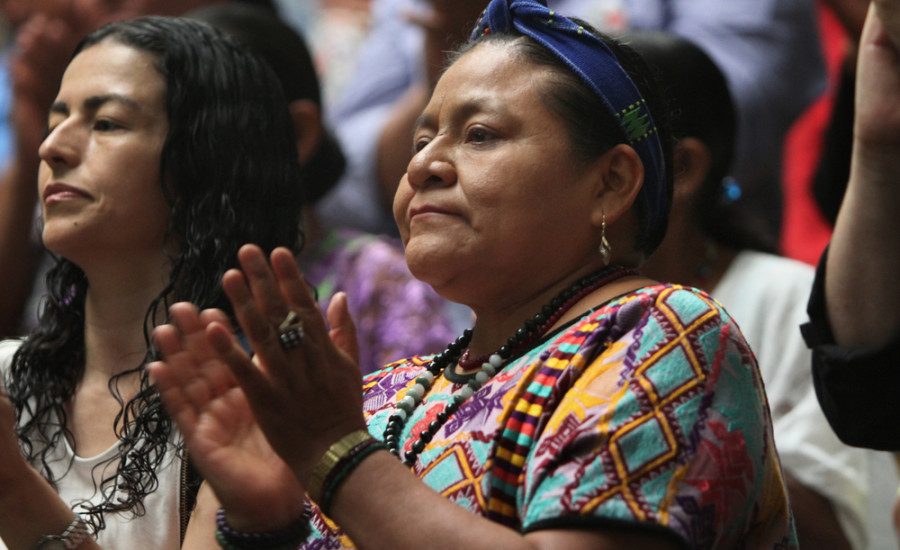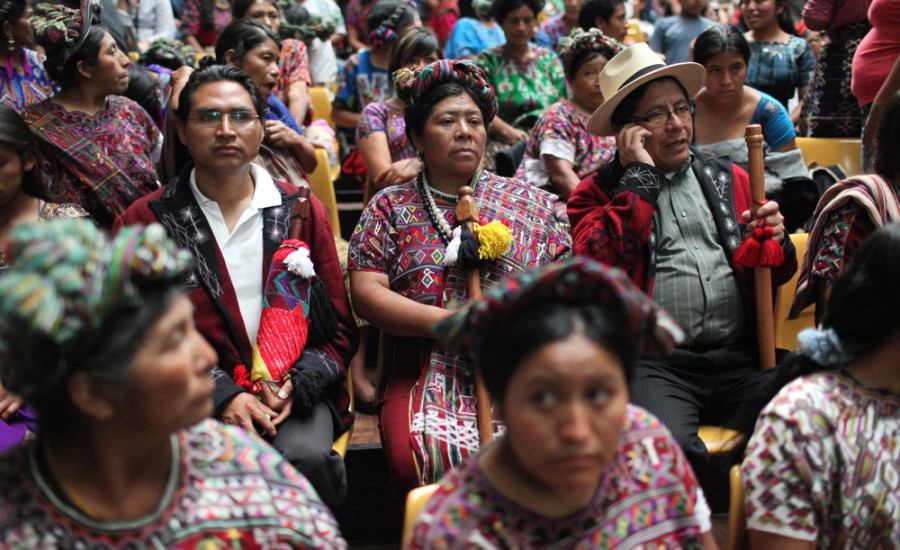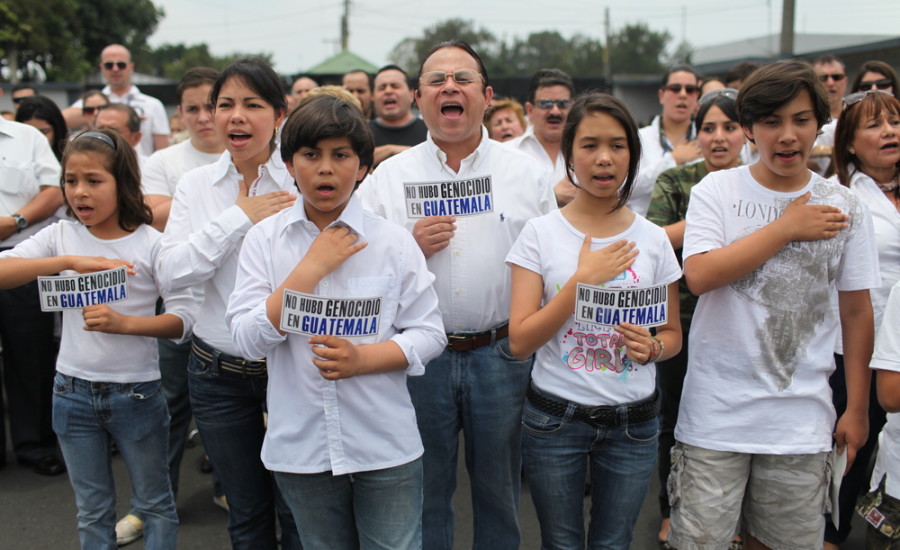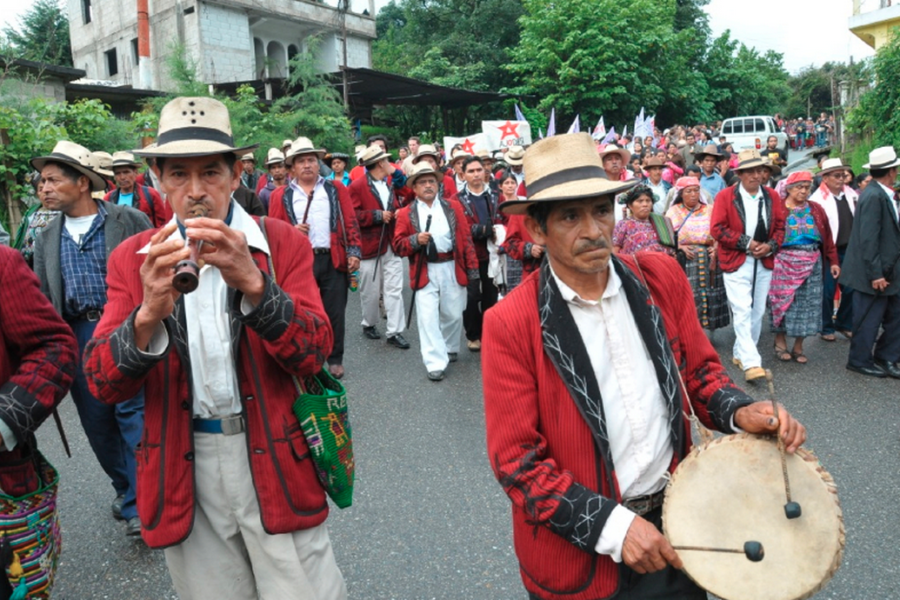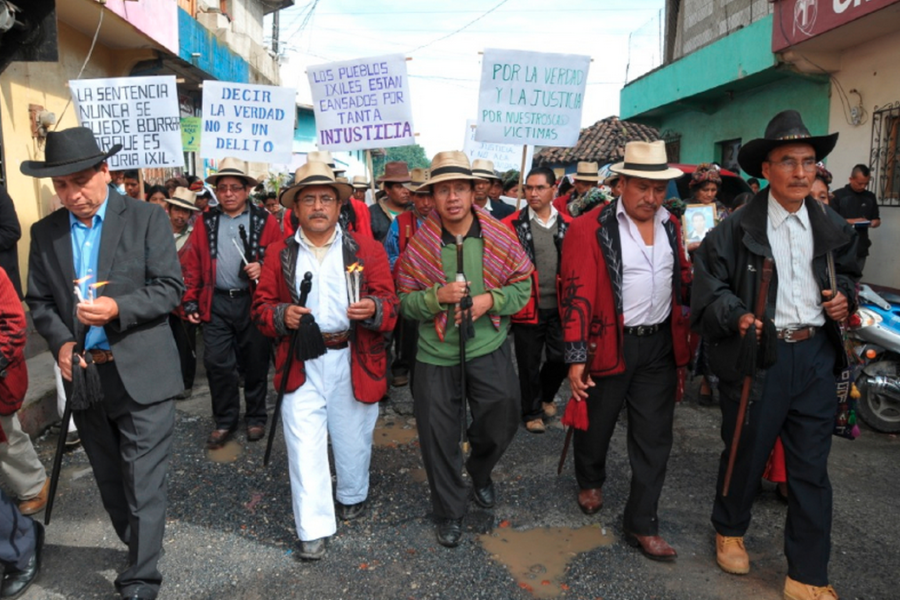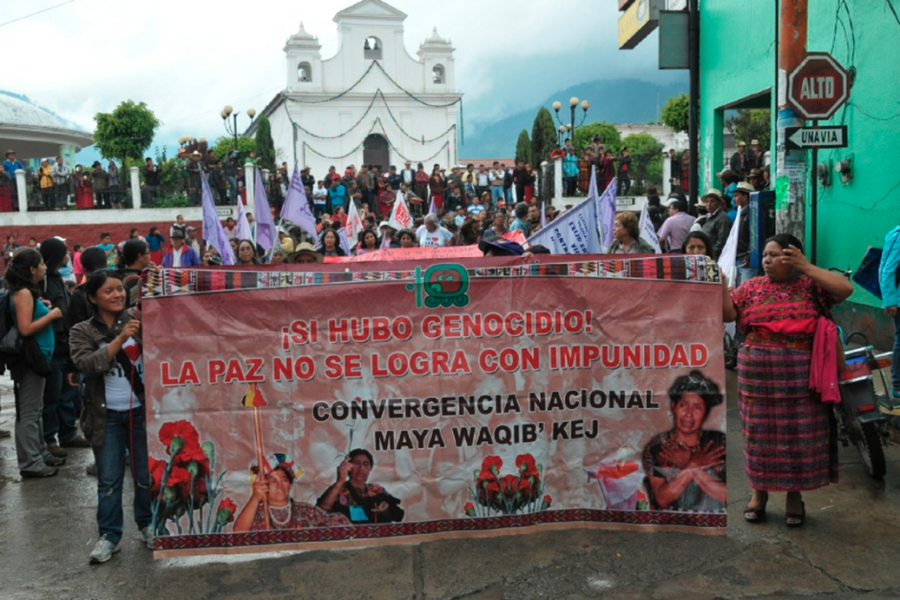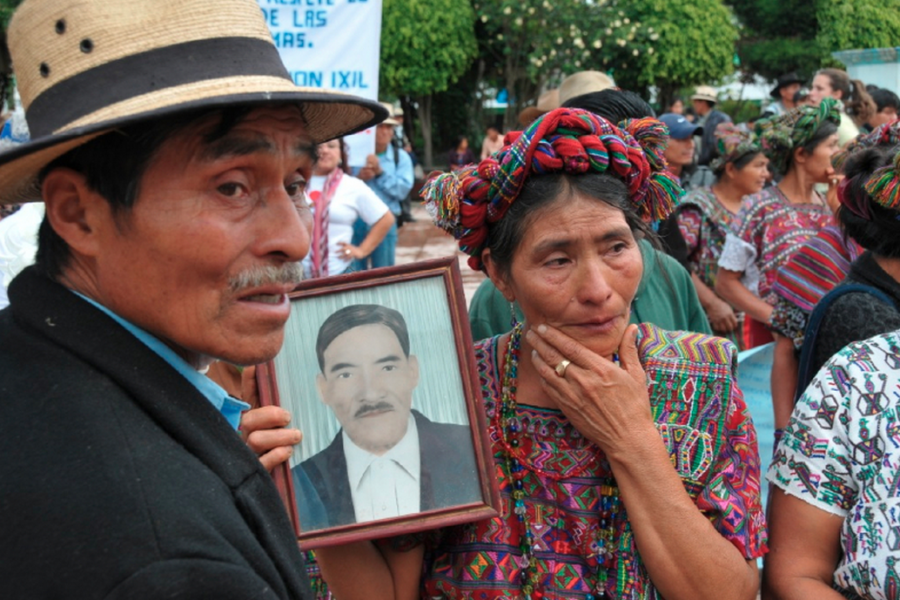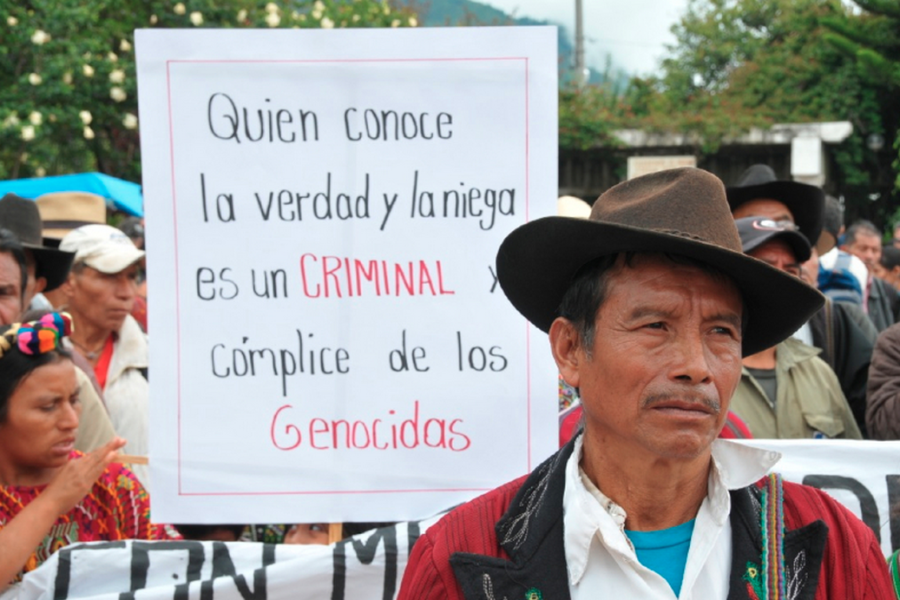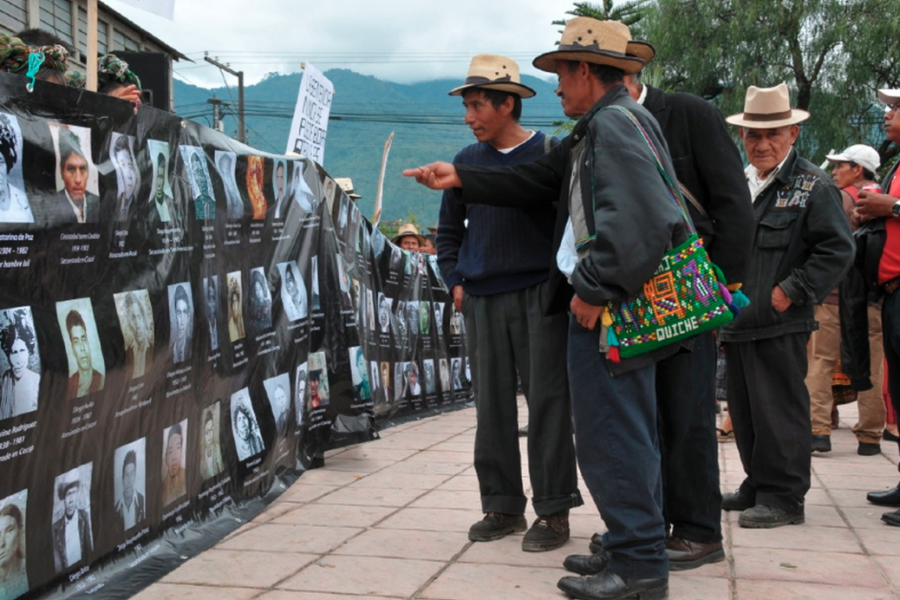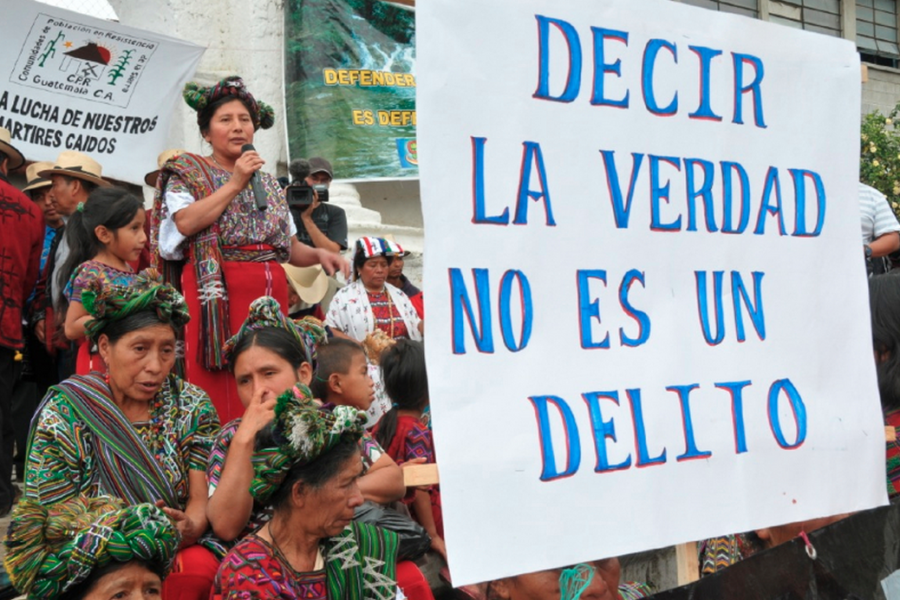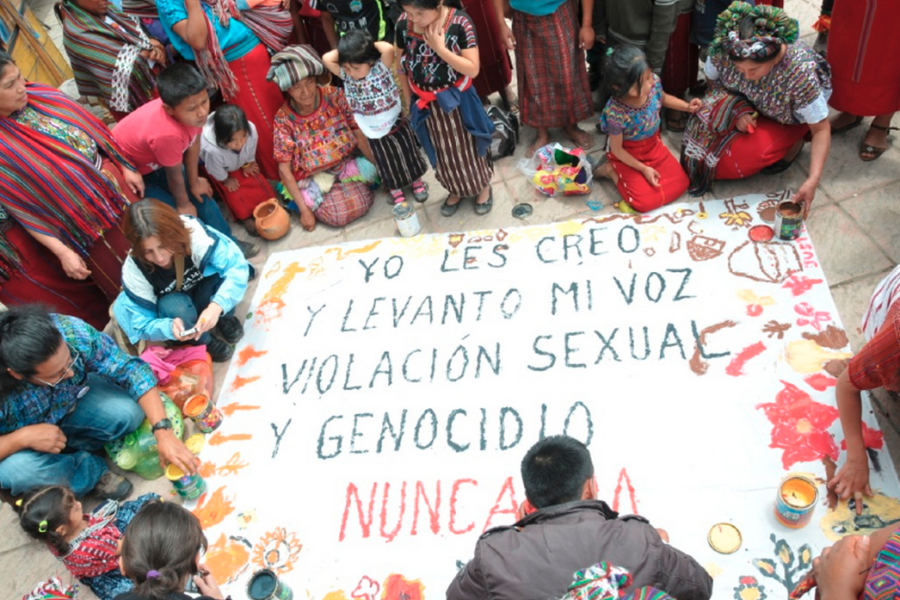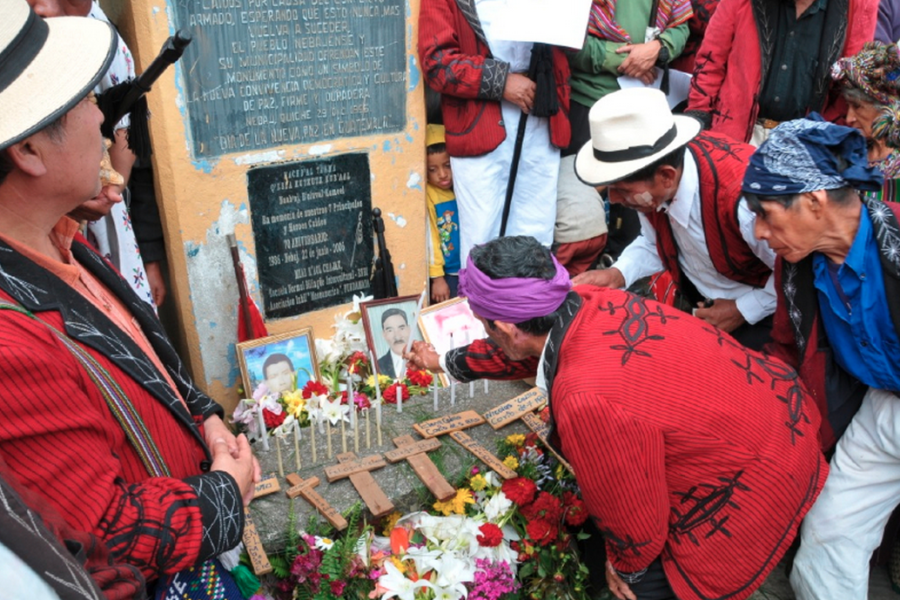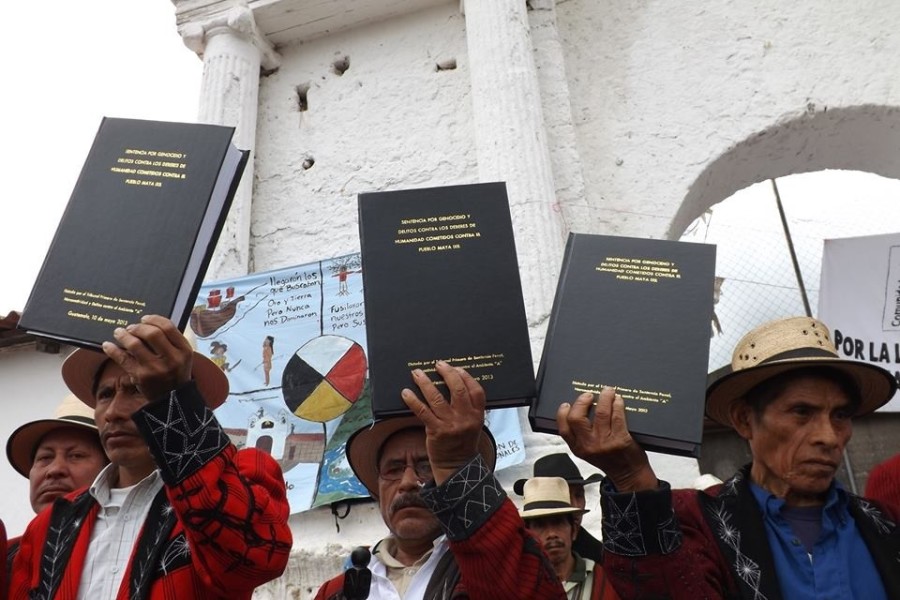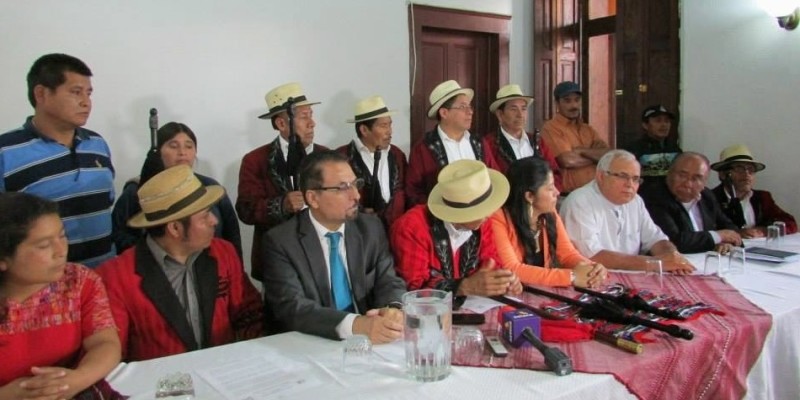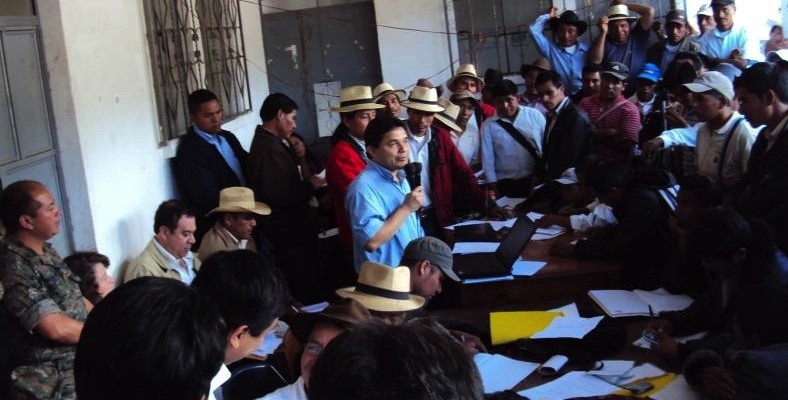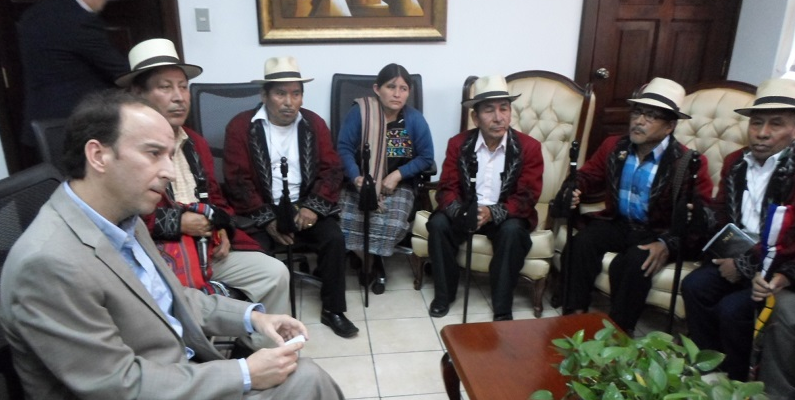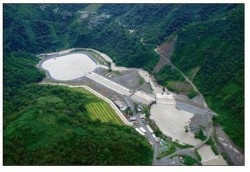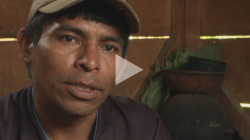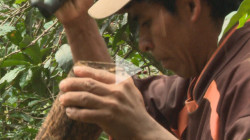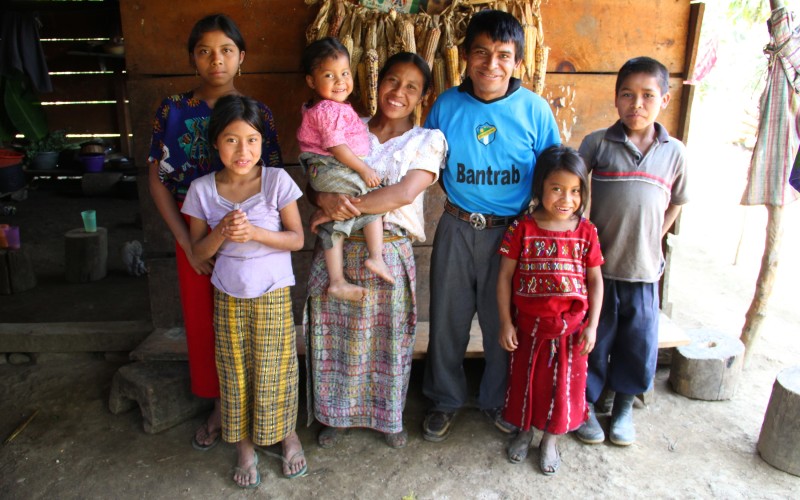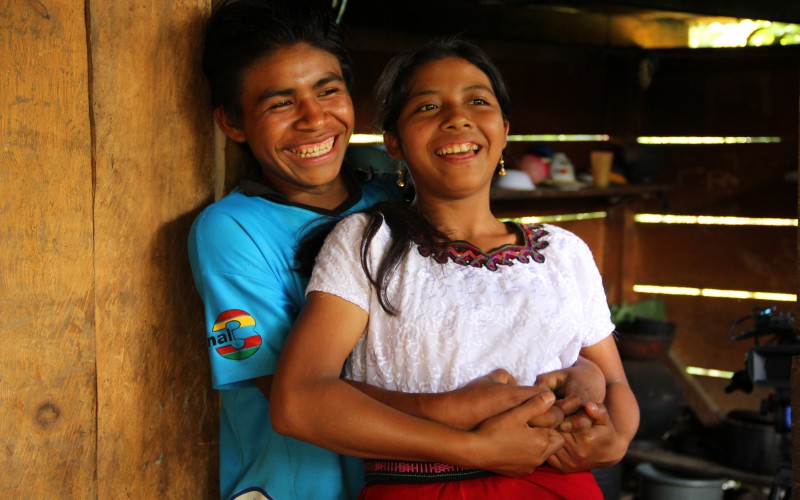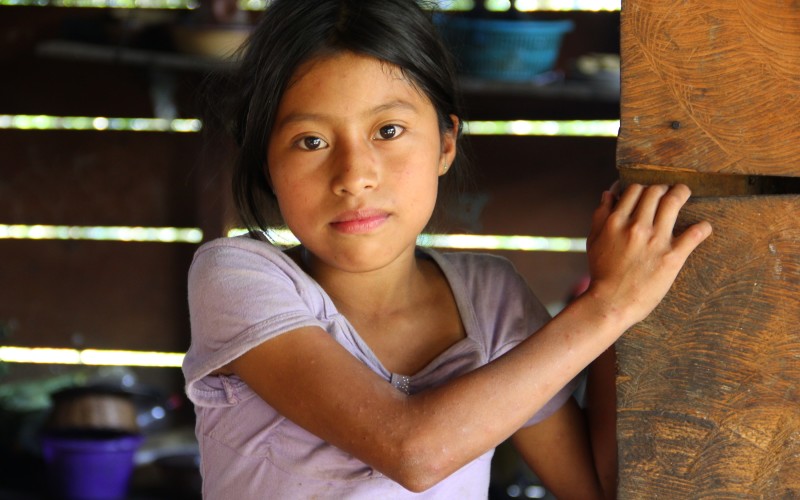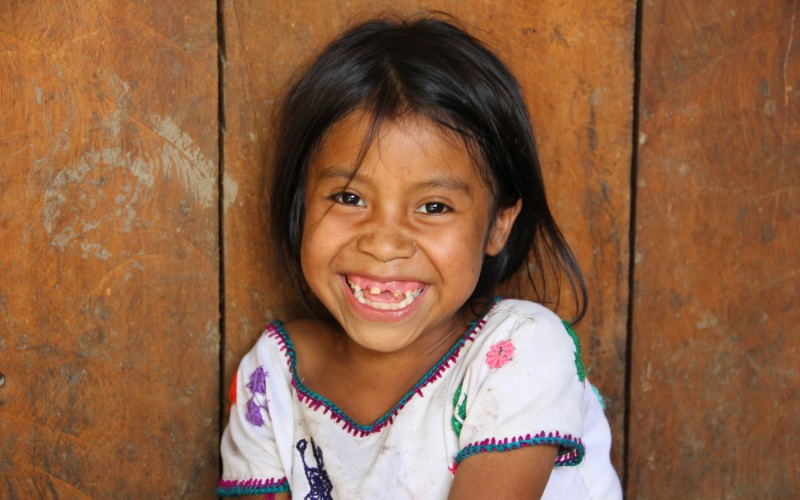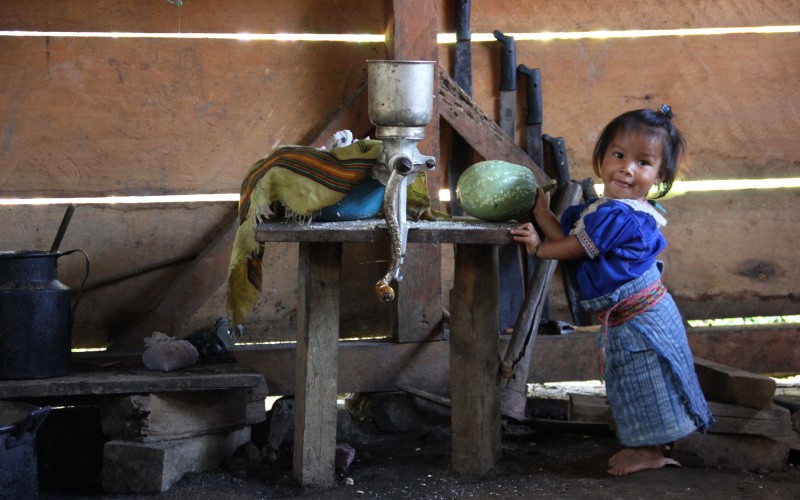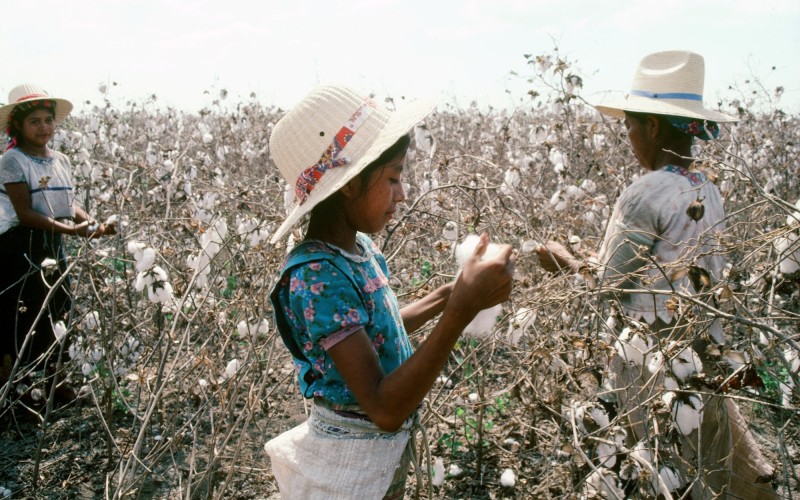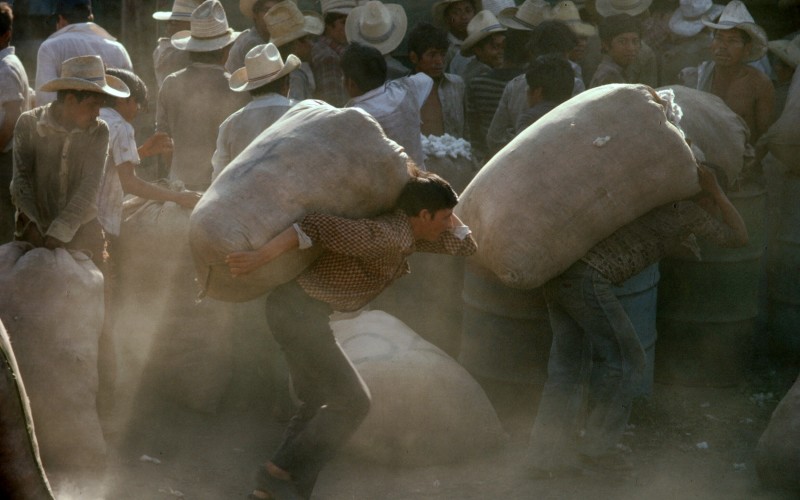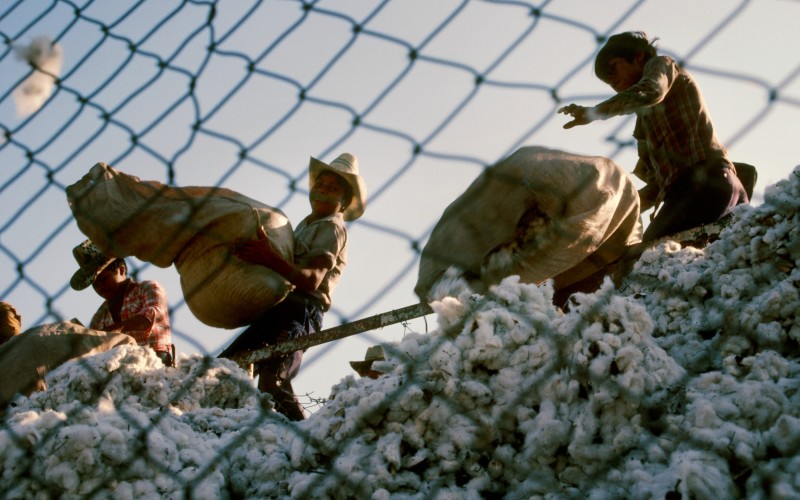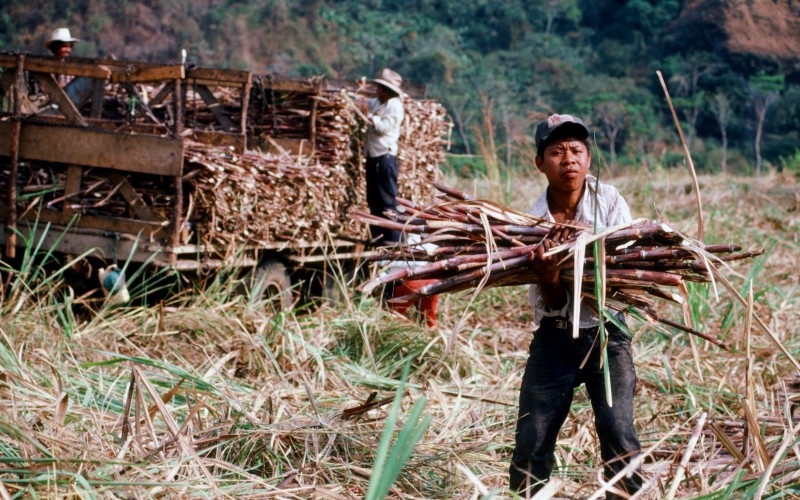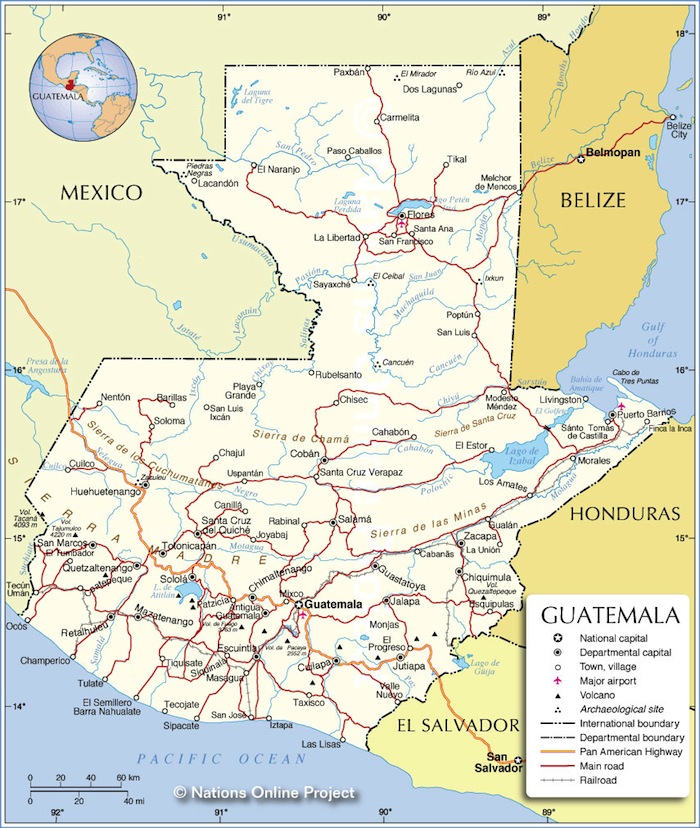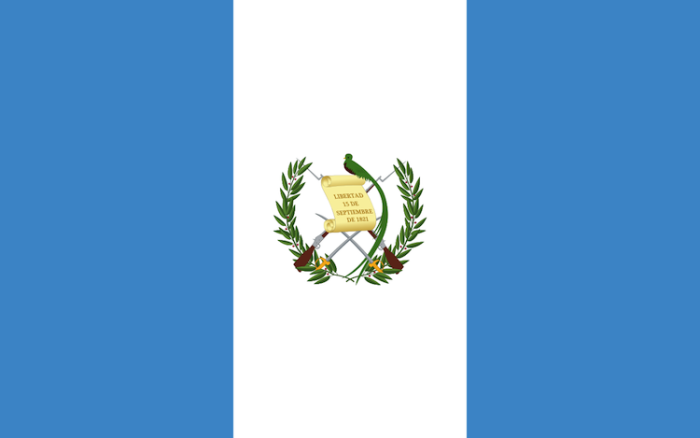Resisting the Army Repression
Sebastián is Ixil, one of Guatemala’s twenty two indigenous Maya groups. They are known for their strong ethnic identity and history of rebellion. By the time he was born in the late 1970s, the Ixil region had become one of the most fiercely contested battlegrounds in the civil war as guerrilla forces attempted to gain control of territory while the military government deployed more and more army troops into the area.
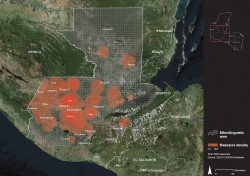
Density of massacres registered by the Commission for Historical Clarification during 36 years of civil war plotted over the ethno-linguistic map of Guatemala. The zone of greatest intensity overlaps with ancestral territory of the Ixil Maya. Visualization by Forensic Architecture and SITU Research.
In 1982-83 the military government pursued a scorched earth policy. The Ixil were subjected to massacres, their homes and villages destroyed, livestock slaughtered, and crops burned. The government’s goal was to depopulate areas where they believed the guerrillas received support.
When the army’s terror swept through the region, massacre survivors initially fled to wherever they could hide, often to the inhospitable surrounding mountains. Thousands fled across the border into Mexico, where many eventually were settled in United Nations refugee camps. Others who were unable to survive or captured were resettled in “model villages” that the army had constructed, sometimes on the ruins of a massacred village. Through mandatory civil patrols, strict monitoring of mobility, food for work programs, and required “re-education” activities, the army attempted to bring the remaining population under its control.
Thousands more people refused to submit to army control, but were unable or unwilling to go Mexico. They lived a semi-nomadic existence in the mountains. The army attacked them constantly, making no distinction between the armed guerrilla combatants in the area and the civilians, including women, children and the elderly. Many people simply died from hunger and illness. Starting in 1982, these people banded together and organized new settlements, which became known as the Communities of Population in Resistance or CPR (Comunidades de Población en Resistencia), which is where Sebastián grew up.
During the first few years, the CPR were constantly fleeing attacks and focused primarily on mere survival. They were forced to move, rebuild and replant many times. They produced food collectively and cooked only at night so that smoke from the fires would not give away their locations. The army destroyed any crops they found, so people turned to native plants and roots when necessary. They consumed animals not commonly eaten, such as snakes or rats. Traditional healers and midwives worked to keep people healthy and the communities attempted to pass on their knowledge and faith to the young people. By the mid 1980s they had achieved an impressive level of organization, which allowed them to avoid army detection and move quickly to temporary safety when attacked.
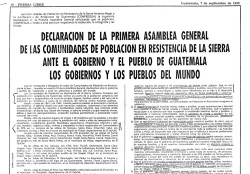
Advertisement in Guatemalan newspaper announcing the existence of the CPR. Prensa Libre, 7 September 1990.
The CPR made themselves known publicly in 1990 through a paid advertisement in the Guatemalan press. They demanded to be recognized as a civilian population; an end to the repression; demilitarization of the region; the right to return safely to their places of origin; and freedom of movement, organization, and expression as well as the right to trade and communicate with neighboring communities.
Non-governmental, religious, human rights and grassroots organizations responded by creating a Multi-Party Commission to act as the “voice” of the CPR as they reached out to contact the Guatemalan government and outside world. The Commission organized delegations, took testimony and issued reports, affirming the legitimacy of the CPR’s demands. Sebastián was filmed in 1991 during once such delegation visit.
Estimates suggest that between 15 – 30,000 people lived in the CPR, many of whom were Ixil, as a portion of the approximately 1.5 million people overall who were displaced by the war. (See Dora: What Does It Mean To Be Displaced?) Some people stayed in the CPR for over a decade.
The CPR disbanded in 1996 when the Peace Accords formally ended the war. Some of the people returned to whatever was left of their original villages and others were re-settled on land along Guatemala’s southern coast. Sebastián left the CPR in the mid-1990s and moved to the small community where he lives today, which belongs to the municipality of Chajul.
There is still a CPR organization today. At their 2013 General Assembly, they issued a declaration stating that once again their communities of origin and the new places they’ve settled are facing threats from the government, corrupt local authorities, and national and foreign companies that “want to seize the riches of our Mother Earth.” They condemn the government for installing new military bases in the areas where the natural resource extraction is occurring. Finally, they issued a call for unity in order to transform the “oppressive system” that today continues in Guatemala.
SOURCES & LINKS
Ball, Patrick, Paul Kobrak and Herbert F. Spirer. State Violence in Guatemala, 1960-1996: A Quantitative Reflection. Washington, DC: AAAS, 1999. Chapter 20: Populations in Resistance, pp. 106-109.
https://hrdag.org/wp-content/uploads/2013/01/state-violence-guate-1999.pdf
Guatemala Health Rights Support Project. “Communities of Population in Resistance (CPR).” 1992.
http://arks.princeton.edu/ark:/88435/dv13zv26d
Moller, Jonathan. Our Culture Is Our Resistance: Repression, Refuge, and Healing in Guatemala. New York: powerHouseCultural Entertainment, Inc., 2004.
http://www.opensocietyfoundations.org/moving-walls/7/our-culture-our-resistance-repression-refuge-and-healing-guatemala
Perera, Victor. Unfinished Conquest: The Guatemalan Tragedy. Berkeley: University of California Press, 1993.
Resistencia de los Pueblos. “Declaración de la XXIII Asamblea General de las CPR de la Sierra.” mayo de 2013.
http://resistenciadlp.webcindario.com/libros.html#
Was Anyone Punished for the Massacre?
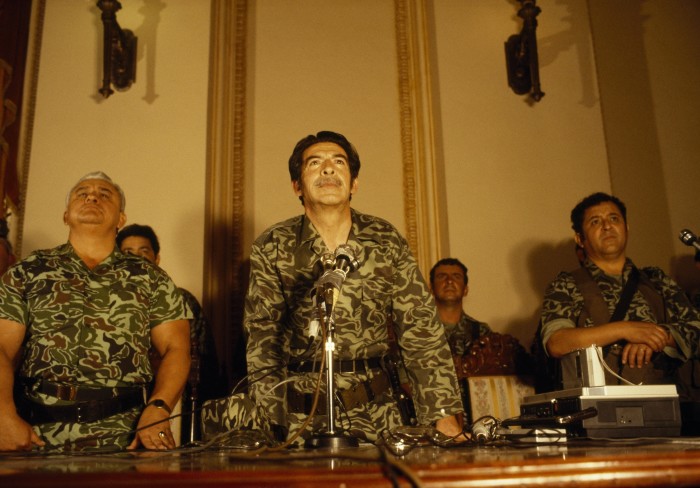
Gen. José Efraín Ríos Montt (center) at first press conference after seizing power in military coup. 23 March 1982, National Palace, Guatemala City, Guatemala. Photo courtesy of Jean-Marie Simon.
In 2013, Guatemalan dictator Gen. José Efraín Ríos Montt was tried for crimes against humanity and genocide against the Ixil people, including the deaths of 1771 people and the forced displacement of 29,000 others. His chief of military intelligence, José Mauricio Rodríguez Sánchez, was also on trial. The charges were a result of the army’s systematic massacres and scorched earth policy directed toward the indigenous population in the Ixil region. The trial took place 30 years after Ríos Montt’s brief rule in 1982-83. He had risen to power through a coup d’état, and lost it in another coup just 18 months later.
Over the course of two months, 90 Ixil survivors or relatives of victims testified about their horrific experiences watching loved ones tortured and slaughtered with unfathomable cruelty. These witnesses laid out the experience of the Ixil people as they endured bombings, displacement, fear, near starvation and forced participation in the civil patrols and other military activities. Ten brave women kept their faces covered when describing the brutal sexual violence they suffered.
The prosecution often asked the witnesses what it meant and felt like for them to be testifying. According to a Cultural Survival report, their answers “ranged from expressions of pain and loneliness over loved ones lost, to relief at finally having the chance to give voice to the trauma they have carried for three decades. Many also expressed their fervent desire to protect their children from experiencing another genocide. Some spoke about testifying in memory or honor of a family member who was killed. Multiple witnesses insisted, repeatedly, that they were telling the truth, had no reason to lie, and wanted to make sure that their stories were believed.”
Many expert witnesses also testified. The director of the Guatemalan Forensic Anthropology Foundation stated that between 1992 and 2009, his organization exhumed the remains of 420 people from the Ixil region killed in the early 1980s. A third were under age 18 and many were women. (See Diego: Who Is Digging?)
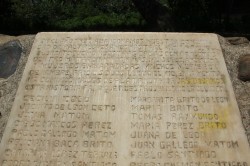
“In 1982, we abandoned our community and we didn’t return until 1992. The army burned our houses with people inside. They killed boys and girls, women, old people and pregnant women. Many died of hunger, cold or drowned in the river. In the mountains we ate plantain roots and herbs. We leave this history so that our children will not forget it” –inscription on plaque in Sebastián’s village.
A geography professor from the University of Arizona testified that the military’s goal in the Ixil region, based on their own internal documents, was to systematically annihilate the enemy, which they defined as the entire Ixil population – every man, woman and child. Next, the army would gain control of the territory. Those people not killed by the massacres of the scorched earth policy would be displaced, allowing the army to capture them and forcibly resettle them into the “model villages,” where they would be under army control, subjected to re-education programs, and obligated to participate in the civil patrols.
A military expert attested to the strict command structure of the Guatemalan military forces and suggested that a single command from Ríos Montt could have changed the entire situation. A legal expert argued that three basic international law principles were violated in Guatemala: the distinction between military targets and civilians; the requirement that civilian causalities be proportionate to the military benefit of the attack; and the prohibition of unnecessary suffering.
A three judge panel found Ríos Montt guilty of both genocide and crimes against humanity. In a 718-page judgment, they stated that during his tenure the armed forces acted to eliminate the Ixil population as a group because they were considered to be guerrilla supporters. He was sentenced to 80 years. A packed courtroom jumped to their feet and erupted into cries of “Justicia! Justicia!” as the judge ordered Ríos Montt to be taken to prison and immediately begin serving his sentence.
The verdict turned out to be short lived, as a mere ten days after Ríos Montt was found guilty, he was back home under house arrest. The Guatemalan Constitutional Court, perhaps succumbing to intense pressure from the country’s powerful military and business sectors, annulled the judgment on a procedural technicality and ordered a new trial. A year and a half later, on January 5, 2015, a new trial began. The eighty eight year old Ríos Montt was brought in on a gurney, which some considered political theater as his health had been quite robust. By the end of the day the trial had been suspended yet again, due to controversy over the impartiality of one of the judges.
Independent of what happens to Ríos Montt himself, the eyewitness accounts of the Ixil, coupled with the expert testimonies, are part of a public record that proves incontrovertibly that genocide occurred. As Kate Doyle of the National Security Archive wrote, the verdict went beyond simply condemning the army’s brutality: “It was also an acknowledgment that the systematic destruction of Mayan communities was the most radical expression possible of the racism, social exclusion and abuse that Guatemala’s indigenous people had endured for hundreds of years. In that sense, the trial sought to restore a measure of dignity to the victims and survivors by recognizing the totality of their historical experience instead of simply the death, pain and loss that each person suffered.”
General Efraín Ríos Montt died on April 1, 2018. He was 91 years old.
SOURCES & LINKS
Canby, Peter. “The Maya Genocide Trial.” The New Yorker, May 3, 2013.
http://www.newyorker.com/news/daily-comment/the-maya-genocide-trial
Commission for Historical Clarification. “Guatemala: Memory of Silence.” 1999.
https://hrdag.org/wp-content/uploads/2013/01/CEHreport-english.pdf
Cultural Survival. “A Summary of the Guatemalan Genocide Trial.” April 18, 2013.
http://www.culturalsurvival.org/news/summary-guatemalan-genocide-trial
Doyle, Kate. “Guatemala’s Genocide on Trial.” The Nation, June 10-17, 2013.
http://www.thenation.com/article/174488/guatemalas-genocide-trial#
Forensic Architecture. “Guatemala: Operación Sofia, Environmental violence and genocide in the Ixil Triangle.”
http://www.forensic-architecture.org/case/guatemala-operacion-sofia/
Kinzer, Stephen. “Efraín Ríos Montt, Guatemalan Dictator Convicted of Genocide, Dies at 91.” New York Times, April 1, 2018.
https://www.nytimes.com/2018/04/01/obituaries/efrain-rios-montt-guatemala-dead.html
Malkin, Elizabeth. “In Effort to Try Dictator, Guatemala Shows New Judicial Might.” New York Times, March 16, 2013.
http://www.nytimes.com/2013/03/17/world/americas/victims-of-guatemala-civil-war-eagerly-await-dictators-trial.html?_r=0
Myers, Laura. “Human Rights in Latin America: The Rios Montt Genocide Trial.” The Globalist, May 15, 2013.
http://www.theglobalist.com/view-from-chajul-the-rios-montt-genocide-trial/
National Security Archive. “Electronic Briefing Books No. 419 and 425.”
http://nsarchive.gwu.edu/NSAEBB/NSAEBB419/
http://nsarchive.gwu.edu/NSAEBB/NSAEBB425/
––––––. “Genocide Trial against Ríos Montt; Declassified Documents Provide Key Evidence.” Unredacted, February 2, 2012.
https://nsarchive.wordpress.com/2012/02/02/genocide-trial-against-rios-montt-declassified-documents-provide-key-evidence/
Open Society Justice Initiative. “Guatemala Trials.” International Justice Monitor.
http://www.ijmonitor.org/category/guatemala-trials/
––––––.“Judging A Dictator: The Trial of Guatemala’s Ríos Montt.” International Justice Monitor.
http://www.opensocietyfoundations.org/sites/default/files/judging-dicatator-trial-guatemala-rios-montt-11072013.pdf
Painter, James. “General Efrain Rios Montt: Former Guatemalan Dictator who got away with mass murder.” Independent, April 2, 2018.
https://www.independent.co.uk/news/world/americas/efrain-rios-montt-guatemala-dictator-dead-died-age-genocide-mass-murder-a8284936.html
Conflicts in the Ixil Region Today
The war left the Ixil region devastated. The massive displacement and destruction affected nearly every Ixil family. Since the war ended in 1996, the Ixil people have returned, rebuilt and continue to reconstruct their lives.
Today the Ixil people face new challenges due to large scale mining and hydroelectric projects. The Guatemalan government grants licenses to operate such projects to mostly large multinational companies who promise economic development for the region. But such projects often pose serious social, cultural and environmental threats, adversely impacting the overall health and welfare of the local people, who have organized to resist them. In additional, local people often see no benefit to them or their communities from such projects.
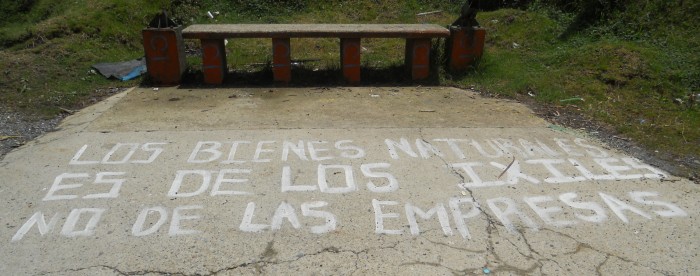
“Natural resources belong to the Ixil, not the companies.” Along the road outside Nebaj, Guatemala, 2012.
International human rights laws stipulate that indigenous groups have the right of “free, prior and informed consent” regarding any exploration or exploitation of resources on their lands, as well as the right to compensation for damages and to share in the benefits of such activities. So far none of the mining or hydroelectric projects in the Ixil region have complied with those laws in a way that has satisfied the local population.
A few examples of such projects highlight new clashes that have resulted, as well as underline the historic conflicts related to land ownership.
Barite, which is used for oil and gas drilling, including fracking, is found in the region. Mining started in the 1980s to remove barite from forest lands that are communally owned and managed by the Ixil, who have resisted the intrusion ever since. In 2001, the Guatemalan government issued an extraction license but several years later the water sources that thousands of people in the surrounding communities relied on dried up. Local opposition prevented the company from continuing to operate.
In 2014, a US company purchased the mining rights, sparking new protests. In an open letter, leaders from the affected communities wrote: “Historically, we have never received the support of the state or the government for our development, which is why it seems fair that we be able to take advantage of our own natural resources in order to improve the living conditions of our people according to our own vision of development.”
As of early 2015, Ixil opposition to the project had prevented it from moving ahead, but the license is official until 2021. Given the high profitability of barite, the conflict over the mine will likely flare up again in the future.
Hydroelectric power is another flashpoint in the debate around exploitation of natural resources. While considered a renewable energy source, dams and associated power plants can create many negative environmental and social impacts. Two such projects located on the largest coffee plantations in the Ixil region highlight the complex issues involved.
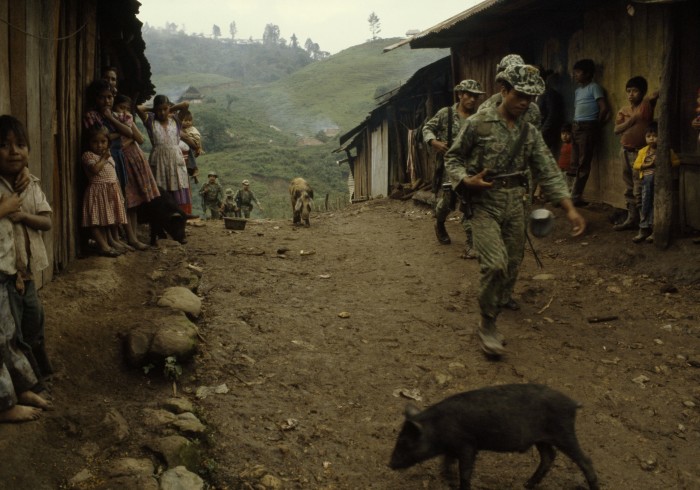
Army occupation of La Perla coffee plantation, Chajul, Quiché, Guatemala, 1982. Photo courtesy of Jean-Marie Simon.
The La Perla and San Francisco coffee plantations are quite far apart and owned by different families but share some common history. Both grew to their current sizes (approximately 22 and 55 square miles respectively) by seizing municipal or communal land belonging to the Ixil in the 1900s. Both were notorious for their abusive treatment of their workers. During the civil war, both plantations experienced violence. When coffee prices dropped in the early 2000s, the owners of both plantations turned to the water flowing through their lands as a source of revenue, teaming up with different transnational companies to construct dams and hydropower plants on their land.
There have been many protests by the Ixil ever since, although some people favor the projects and benefit from short-term employment. Ixil leaders claim that no genuine free, prior and informed consent process took place. They question the government’s authority to grant licenses (and with what terms) for outsiders to come in and exploit the natural resources that have been utilized by their people for centuries. They highlight the role of corrupt local and national officials in consenting to such endeavors. They argue that when agreements have been reached regarding compensation, that the promises have not been kept.
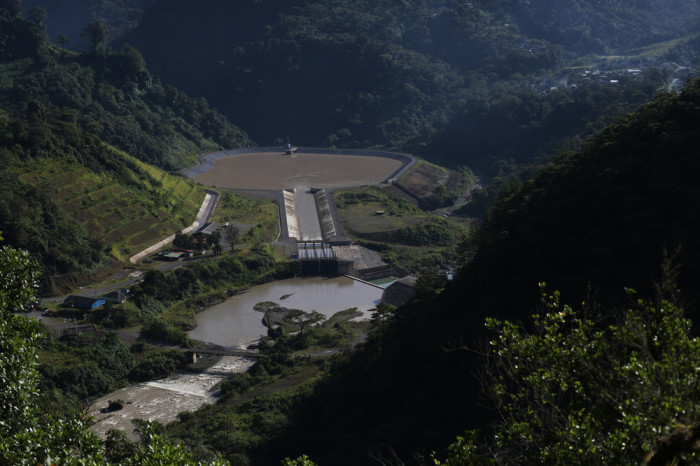
The Xacbal Hydroelectric Dam and the town of Juá near La Perla finca, Chajul, Quiché, Guatemala. August 2012. Photo by James Rodríguez/MiMundo.org.
In 2012, the Guatemalan government granted a 50 year license to the company operating on La Perla to construct a second dam and power plant, eliciting more protests. In the spring of 2015 residents blocked the road leading to the dam because they had not received the promised compensation for their lands that were damaged by the construction. Police were sent to remove the protestors.
For years, Ixil leaders have petitioned the government to annul all mining and hydroelectric licenses granted on Ixil territory, to no avail. They charge that the hydroelectric projects promised to bring electricity to the communities their power lines cross; to build and improve roads; and to employ people from the surrounding areas. They state that “none of those promises were kept and the only ones who saw any development were the multinationals, which came at the cost of social, environmental, cultural and spiritual damage to a people with vision and their own model of development.”
SOURCES & LINKS
Alcaldías Indígenas de la Región Ixil. “HIDROXIL, S.A. Una empresa más sin voluntad de dialogar y respetar el sentir y pensar del pueblo ixil.” August 3, 2013.
http://alcaldiasindigenasixiles.blogspot.com/2013/08/hidroxil-sa-una-empresa-mas-sin.html
Central American Data.com. “Guatemala Authorizes Hydroelectric Station.” October 16, 2012.
http://en.centralamericadata.com/en/article/home/Guatemala_Authorizes_Hydroelectric_Station
Centro de Medios Independientes. “Exigimos al estado y a las empress.” February 23, 2015.
http://cmiguate.org/exigimos-al-estado-y-a-las-empresas-respetar-nuestra-vida-medios-de-vida-y-la-vida-de-las-futuras-generaciones/
Dalmasso, Simone. “El tortuoso y largo camino para poser enterrarlos.” Plaza Pública, December 10, 2014.
http://www.plazapublica.com.gt/content/el-tortuoso-y-largo-camino-para-poder-enterrarlos
Escalón, Sebastián. “Hidroeléctricas: ir al fondo de sus contradictions.” Plaza Pública, June 29, 2012.
http://www.plazapublica.com.gt/content/hidroelectricas-ir-al-fondo-de-sus-contradicciones
––––––. “La hidroeléctrica de ENEL, sus aliados poco ortodoxos y el diálogo.” Plaza Pública, July 2, 2012.
http://www.plazapublica.com.gt/content/los-aliados-poco-ortodoxos-de-la-hidroelectrica-de-enel-y-el-dialogo-ii
Figueroa, Oscar. “Agente de la PNC resulta herido en desalojo de camino hacia hidroeléctrica.” Prensa Libre, April 28, 2015.
http://www.prensalibre.com/guatemala/quiche/agente-de-la-pnc-resulta-herido-en-desalojo-de-camino-hacia-hidroelectrica
NISGUA Blog. “Ixil communities of Nebaj express opposition to US-led extraction in their territory.” September 18, 2014.
http://nisgua.blogspot.com/2014/09/ixil-communities-of-nebaj-express.html
Portalewska, Agnes. “Free, Prior and Informed Consent.” Cultural Survival, December 2012.
http://www.culturalsurvival.org/publications/cultural-survival-quarterly/free-prior-and-informed-consent-protecting-indigenous
Reynolds, Louisa. “Construcción de hidroeléctrica Xacbal genera descontento en población Ixil.” albedrío.org, July 24, 2007.
http://www.albedrio.org/htm/articulos/l/lr-028.htm
Roberts, Tobias. “Corporate Rights Over People’s Rights.” Latin America Advocacy Blog, February 7, 2013.
http://www.mcclaca.org/corporate-rights-over-peoples-rights-the-expansion-of-enel-in-latin-america/
––––––. “Mining Resistance: Lessons from Guatemala and Mexico.” Latin America Advocacy Blog, February 4, 2015.
http://www.mcclaca.org/mining-resistance-lessons-from-guatemala-and-mexico/
––––––. “The Other Side of Fracking.” The Huffington Post, August 9, 2014.
https://www.huffingtonpost.com/entry/the-other-side-of-fracking_b_5476952.html
Struggling to Provide for Your Family
Sebastián lives in a one-room house typically found in rural areas. This room serves as a bedroom for him, his wife and their youngest children; they also cook over an open fire and eat there. The older children sleep in a small separate hut. Like most houses in small rural communities, there’s no indoor plumbing.
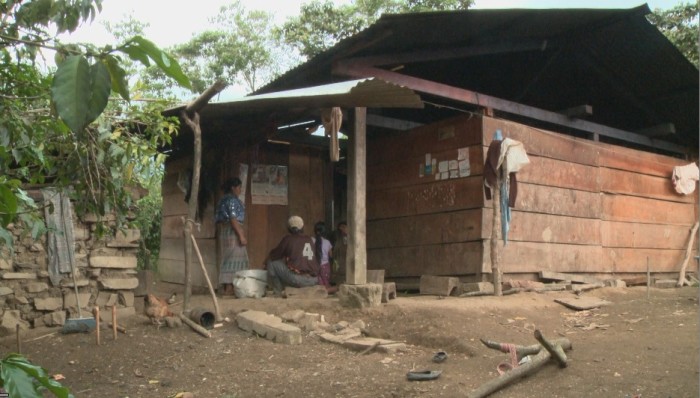
Sebastián’s house.
The houses in Sebastián’s community, where about 125 families live, are sprinkled in between small plots of coffee. The paths that connect them are steep and become slick and difficult to negotiate in the rainy season. There is no real town center, just a primary school with several classrooms. One Catholic and several evangelical churches, all in modest one room buildings, are spread around the hamlet.
Happily, about a year after this interview, a rudimentary road was built connecting Sebastián’s community with its larger neighbor, Chajul, which has a population of about 20,000. The road is steep and not passable if there’s too much mud and only certain vehicles can navigate it. Some people simply don’t have the money to pay for a ride, which takes about an hour and a half, but the road is still a huge improvement for many in Sebastián’s small village.
Sebastián says his family always has corn and beans. These may stave off hunger but they do not provide a balanced diet, which results in chronic malnutrition and stunted growth, and makes young children more vulnerable to health problems. Lack of proper nutrition can also have a serious effect on a child’s ability to concentrate at school, contributing to high drop out and illiteracy rates.
Cooking over an open fire, as is customary in rural Guatemala, is a pressing health and environmental problem. Household air pollution from the smoke disproportionately affects women and young children, who spend much of their time inside. As a result, they are more susceptible to respiratory problems and later often die prematurely from pneumonia, heart and lung diseases, and strokes. Cooking over an open fire requires large amounts of wood for fuel, contributing to deforestation and damage to watersheds and habitats. The search for wood can be very taxing for the family, depending on how far away they must walk to find it.
Some rural families, like Sebastián’s, have a pipe delivering water to their houses, but it’s often unsafe for drinking. It may come from contaminated water sources or be stored in unsanitary containers. Many women still bear the burden of carrying water back to their homes from a source that can be far away, which also is unlikely to be clean. Unsafe drinking water means more chance of sickness, causing children to miss school and requiring the family to buy medications or pay for a visit to a clinic, if available.
In Sebastián’s village, there are community health workers, who have very basic training but often no access to medical supplies or medications. If someone gets seriously ill or injured or if a woman has trouble in childbirth, they have to try to get to town as quickly as possible. The closest town, Chajul, has only a clinic. Any problem requiring a hospital means a trip to Nebaj, another hour away.
Sebastián’s younger children attend the local primary school, although buying pencils, notebooks, shoes and clothing (many schools require uniforms) is prohibitive for many families. At around age 10, Sebastián’s children stop going to school in order to work, which often happens in poor families in both rural and urban areas. The nearest middle school is in Chajul, meaning the family would have to pay room and board for a child to study there, an impossible expense for almost everyone in his community.
With little or no formal education, men have few options other than to be subsistence farmers. Even that can be very challenging, as land is poor for crops in the mountainous Ixil region and often people do not own enough land to adequately support their families. Sebastián owns a small amount of land around his house and where he collects some of his wood from, but he rents the land he plants in corn and beans.
Sebastián and his older sons seek work as day laborers on small plots of land planted in coffee in the area. That work is not only physically demanding, but sporadic. They cannot rely on a steady income nor predict what they might earn in any given week or month. Some people in Sebastián’s village own mules which they hire out, but not many are able to save enough to make the initial purchase. Others migrate to large coffee, cotton, or sugarcane plantations outside the region to work during the harvest season, usually for about two months each year. Those workers are highly exploited, live in unsuitable conditions, are exposed to pesticides and often return home sick and with very little money.
In the thousands of small villages like Sebastián’s that dot the Guatemalan countryside, there are no governmental social safety nets. Programs like housing subsidies, food stamps, welfare payments, affordable health care, and worker benefits simply do not exist. When there is a natural disaster or a war, families and communities are left to their own devices to pull through.
SOURCES & LINKS
Bernstein, Joanna. “After fleeing Guatemala, some Ixil immigrants are seeing Pittsburg as a destination for a new community,” Public Source, 29 January 2019
https://www.publicsource.org/undocumented-in-pittsburgh-after-fleeing-guatemala-ixil-immigrants-see-the-city-as-a-new-community/
Limitless Horizons
http://limitlesshorizonsixil.org/
Living on One Dollar/Change Series
http://livingonone.org/changeseries/
World Health Organization. “Household air pollution and health.” Fact sheet No. 292, Updated March 2014.
http://www.who.int/mediacentre/factsheets/fs292/en/
Guatemala Maps & Facts
Size: 41,699 sq. miles, size of Tennessee
Population: 15,470,000 (2013)
Capital: Guatemala City
People: Over half are indigenous Maya; the rest are primarily of mixed Maya and Hispanic heritage, called Ladinos; small population of African descendents (including Garifuna) along Atlantic Coast
Languages: Spanish is the official language; there are 22 Mayan languages spoken as well as Xinca and Garifuna
Religions: Roman Catholic, Protestant (primarily evangelical) and Maya
Independence: 1821 (from Spain)
- Over half the population lives below poverty level.
- Illiteracy, infant mortality and malnutrition rates are among the highest in Latin America.
- Life expectancy is among the lowest in Latin America.
- Nearly one third of all children do not complete primary school.
- All social indicators are worse for the Maya population than for the Ladino.
- The country is plagued by gang and drug related violence and organized crime. It serves as a major corridor for drugs coming to the US from South America.
Quick Facts About the War
Dates: 1960 – 1996 (36 years)
In 1982, the four most important Guatemalan revolutionary organizations fighting against the military regimes and paramilitary right-wing groups created the Guatemalan National Revolutionary Unity (URNG).
Over 200,000 people were killed or disappeared
1.5 million were displaced
669 massacres
83% of victims were Maya & 17% of victims were Ladino
The Turth Commission found that Army and security forces were responsible for 93% of atrocities; the insurgency (guerrillas) for 3%; the remaining 4% were undetermined.
Historical Timeline
2500 BCE – 1501 CE - Maya civilization begins around 2500 BCE and reaches its peak of development beginning around 200 CE. Maya achievements in mathematics, astronomy, architecture, engineering, art, language and agriculture are notable. Around 900 CE Maya cities suffer a decline.
1501 – 1821 – Spanish conquerors began sweeping through the continent. Between 1524 and 1650, about 85% of Maya are killed by weapons and diseases. Many survivors are enslaved, but some flee to the higher mountains. Ceremonial centers are torn down and replaced with Christian churches. Maya leaders and scholars are killed, writings are destroyed.
1821 – 1900 – On September 15, 1821, Guatemala declares independence from Spain. From 1823 -1840, it is part of the United Provinces of Central America (along with El Salvador, Honduras, Nicaragua and Costa Rica). In 1947, Guatemala declares itself an independent republic. Conservatives and Liberals dominate Guatemalan (and Central American) politics. Conservatives represent the interests of wealthy landowners and the Catholic Church, favoring strong central government and a regulated economy. Liberals represent mainly the middle class and merchants, favoring decentralized government, free trade and greater separation of church and state. During the mid-1800s, cultivation and export of coffee creates a new oligarchy of wealthy families.
1900 – 1944 – By 1900, the United States is the dominant economic force in Guatemala. The United Fruit Company becomes the largest landowner, employer and exporter in Guatemala, persuading the government to provide them with land, low taxes and cheap labor. While United Fruit’s profits flourish, most the population suffers malnutrition, high rates of infant mortality, limited access to health care and education and violations of human rights. This leads to wide-scale discontent. The middle class also is frustrated with its own limited economic growth and political power.
1944 – 1954 – Ten-year period of social and democratic reforms, including establishment of a social security system, minimum wage, the legalization of unions, laws to protect workers and national health care. The United Fruit Company and other large landowners threatened by land reform which redistributes their unused lands to landless peasants.
1954 – CIA led coup, promoted by United Fruit and “justified” with Cold War rhetoric, replaces freely elected President Jacobo Arbenz with Colonel Carlos Castillo Armas. The coup is a turning point in modern Guatemalan history, paving the way for decades of repressive military dictators. Castillo repeals the land reform law, represses labor unions and reverses most other social reforms. Widespread crackdown on labor leaders and peasants.
1960 – The beginning of Guatemala’s civil war between government military forces and primarily left-wing insurgents. Peasant, student, community, labor, church and other groups organize and protest nonviolently in the streets. The government responds with increasing repression, using military as well as paramilitary forces, that become known as death squads. In the following two decades, as repression continues, armed insurgents known as guerrillas gain strength, especially in the Maya highland region.
1976 – A severe earthquake kills over 25,000 people and leaves a million homeless, exposing massive social inequities. Anti-government organizing activities increase.
1978 – General Romeo Lucas García becomes president in openly rigged election. Protests and strikes erupt and student and labor leaders, even priests, are assassinated. Peasant groups are massacred.
1982 – Four guerrilla organizations form the Guatemalan National Revolutionary Unity (URNG).
General Efraín Ríos Montt seizes power in a coup and escalates the repression into a “scorched earth” campaign, aimed primarily at certain Maya highland regions where the guerrillas are active.
1983 – Ríos Montt is ousted by General Oscar Mejía Víctores but the bloodshed continues. Terror is everywhere as thousands of people are killed or disappeared. Entire villages are massacred, including men, women and children.
1986 – Vinicio Cerezo, a civilian, assumes the presidency following a legitimate election. The violence diminishes, but does not stop, as the military still wields great power.
1992 – Rigoberta Menchú, a defender of human and Maya rights, wins the Nobel Peace Prize.
1996 – The 36-year long civil war formally ends with a Peace Agreement.
1998 – Bishop Juan Gerardi is assassinated two days after presenting “Guatemala: Never Again!” a report by the Catholic Church on human rights violations during the war, which concludes that 90% were committed by government forces and their paramilitary bands.
1999 – The United Nations sponsored Truth Commission report states that 93% of all human rights violations during the civil war were committed by government security forces; that approximately 200,000 people were killed or disappeared; and that over 600 massacres were carried out.
2006 – Government and UN set up a commission known as CICIG to fight impunity by prosecuting high level criminals. Crime, social injustice and human rights violations continue to afflict Guatemala.
2009 – An ex-military officer and a retired colonel are the first people convicted of crimes committed during the civil war.
2013 – Following an historic trial, former President Ríos Montt is found guilty of crimes against humanity and genocide. Shortly thereafter, the Guatemala Constitutional Court annuls the judgment and orders a new trial.
2015 – Revelations by CICIG of governmental corruption provoke massive protests and demonstrations, resulting in the resignation of both the president and vice president, who are sent to prison. Former comedian Jimmy Morales, whose slogan is “not corrupt nor a thief,” is elected President.
2016 – Former military soldiers are convicted of sexual violence toward and enslaving 15 Maya women during the civil war.

